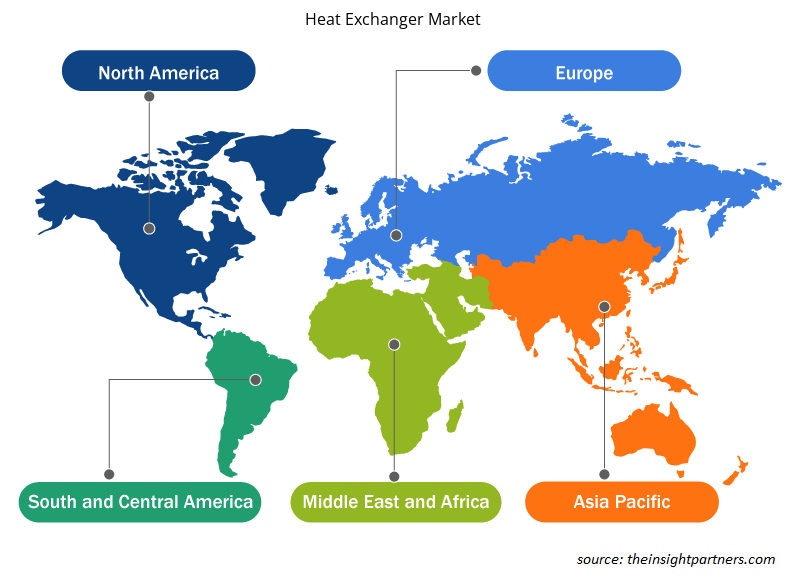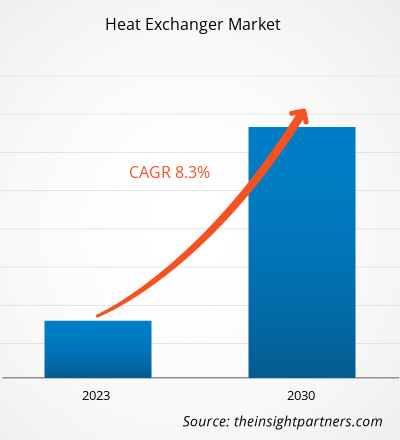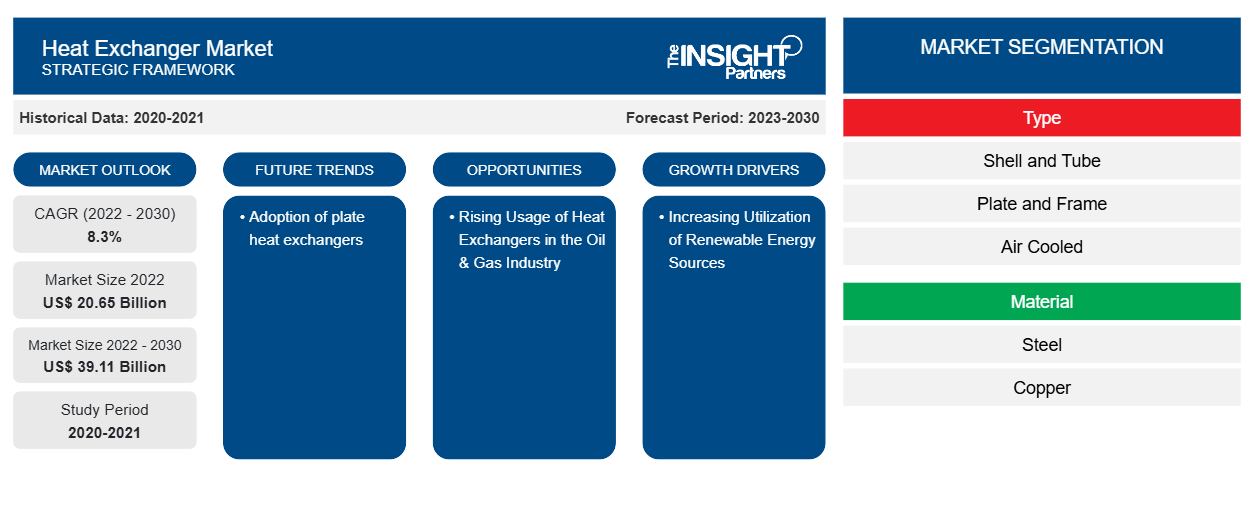预计到 2030 年,热交换器市场规模将从 2022 年的 206.5 亿美元增至 391.1 亿美元。预计 2022-2030 年期间市场复合年增长率将达到 8.3%。板式热交换器的普及率可能仍是市场的主要趋势。
热交换器市场分析
热交换器是一种通常用于加热或冷却元件的设备,具体取决于客户的需求;它主要用于各种工艺和离散行业。该行业使用热交换器进行冷却,以防止关键机械或易燃材料过热。全球热交换器市场正在增长。推动需求的主要工业部门包括能源、化工、食品、暖通空调和船舶等。全球所有主要过程工业都将热交换器用于多种应用。工业 4.0、快速工业化和石油和天然气行业的技术进步都在推动市场的增长。
热交换器市场概况
热交换器市场的制造商 正在推出用于石化和炼油厂的各种产品。例如,2023 年 4 月,移动模块化电源、温度控制和能源解决方案的全球供应商 Aggreko 推出了两个新的租赁热交换器系列——大型节点热交换器和 Hastelloy C 横流热交换器。这款现成的设备为石化和炼油厂客户提供了业内最大的热交换器,也是唯一一款由哈氏合金制成的热交换器。这两款产品的设计都是为了确保石化工厂和炼油厂的平稳运行,并通过保持客户的生产率和改进工厂工艺来处理复杂的化学情况。
定制此报告以满足您的需求
您可以免费定制任何报告,包括本报告的部分内容、国家级分析、Excel 数据包,以及为初创企业和大学提供优惠和折扣
- 获取此报告的关键市场趋势。这个免费样品将包括数据分析,从市场趋势到估计和预测。
热交换器市场驱动因素和机遇
增加可再生能源利用以利于市场
使用风能和阳光等绿色能源发电的趋势日益增长。减少温室气体排放的需要导致全球能源需求增加,这将迫使人们使用热交换器。这些设备位于风力涡轮机内部,它们促进流体在系统中的流动,从而获得一些机械功。另一方面,它们也可以连接到太阳能集热器上,从而吸收来自其表面辐射的一定能量。
石油和天然气行业中热交换器使用率不断上升
根据国际能源署 (IEA) 2023 年 6 月发布的报告,预计 2022 年至 2028 年全球石油需求将增长 6%。到 2028 年,这一数字将达到 1.057 亿桶/日 (mb/d)。由于对石化产品的需求不断增长以及航空业对石油的需求不断增加,需求正在增长。此外,预计对石油和天然气勘探、开采和生产上游部分的投资将达到 2015 年以来的最高值,预计到 2023 年将同比增长 11% 至 5280 亿美元;这将使热交换器市场受益。据《经济时报》报道,2023 年 1 月,印尼国有能源公司的炼油部门 Pertamina 宣布升级其旧炼油厂并建造新炼油厂,从而将其加工能力提高到每天 150 万桶以上。因此,全球石油需求的增长和石油天然气行业的投资促进了石油和天然气的生产,而热交换器用于消除生产过程中产生的热量。
热交换器市场报告细分分析
有助于得出热交换器市场分析的关键部分是类型、材料和应用。
- 根据类型,市场分为壳管式、板框式、风冷式和其他类型。壳管式部分在 2022 年占据了最大的市场份额。
- 根据材料,热交换器市场分为钢、铜和其他。 2022 年,钢铁行业占据了相当大的市场份额。
- 根据应用,市场分为能源、化工、食品和饮料、暖通空调、纸浆和造纸等。2022 年,能源领域占据了最大的市场份额。
热交换器市场份额按地区分析
热交换器市场报告的地理范围主要分为五个区域:北美、亚太、欧洲、中东和非洲、南美和中美。
2022 年,北美占据了市场主导地位。北美热交换器市场分为美国、加拿大和墨西哥。2022 年,美国占据了北美热交换器市场的最大份额。该地区正在采用水力发电,因为它是清洁能源之一,并且正在开发发电厂以满足不断增长的能源需求。例如,根据美国能源部 2021 年 1 月的报告,自 2017 年以来,2019 年水电容量净增加 431 兆瓦。容量来自现有设施、新设施和为非动力水坝 (NPD) 供电,导致 2010 年至 2019 年的总净增长为 1,688 兆瓦。此外,墨西哥正计划建造许多燃气发电厂以增加天然气供应,包括从美国进口天然气。
热交换器
热交换器市场区域洞察
Insight Partners 的分析师已详细解释了预测期内影响热交换器市场的区域趋势和因素。本节还讨论了北美、欧洲、亚太地区、中东和非洲以及南美和中美洲的热交换器市场细分和地理位置。

- 获取热交换器市场的区域特定数据
热交换器市场报告范围
| 报告属性 | 细节 |
|---|---|
| 2022 年市场规模 | 206.5亿美元 |
| 2030 年市场规模 | 391.1亿美元 |
| 全球复合年增长率(2022 - 2030 年) | 8.3% |
| 史料 | 2020-2021 |
| 预测期 | 2023-2030 |
| 涵盖的领域 | 按类型
|
| 覆盖地区和国家 | 北美
|
| 市场领导者和主要公司简介 |
|
热交换器市场参与者密度:了解其对业务动态的影响
热交换器市场正在快速增长,这得益于终端用户需求的不断增长,而这些需求又源于消费者偏好的不断变化、技术进步以及对产品优势的认识不断提高等因素。随着需求的增加,企业正在扩大其产品范围,进行创新以满足消费者的需求,并利用新兴趋势,从而进一步推动市场增长。
市场参与者密度是指在特定市场或行业内运营的企业或公司的分布情况。它表明在给定市场空间中,相对于其规模或总市场价值,有多少竞争对手(市场参与者)存在。
在热交换器市场运营的主要公司有:
- 阿法拉伐公司
- 凯络文控股有限公司
- 丹佛斯公司
- 赛莱默公司
- API 传热公司
- Chart 工业公司
免责声明:上面列出的公司没有按照任何特定顺序排列。

- 获取热交换器市场顶级关键参与者概述
热交换器市场新闻和最新发展
热交换器市场的评估是通过收集一手和二手研究后的定性和定量数据进行的,其中包括重要的公司出版物、协会数据和数据库。下面列出了热交换器市场的一些发展情况:
- L&T Heavy Engineering 获得了墨西哥一家炼油厂最重反应堆之一和螺旋塞式热交换器的订单。(来源:&T Heavy Engineering,新闻稿,2023 年 1 月)
- 江森自控宣布,已在其 YORK 解决方案室内和室外空气处理机组中添加并安装了完全集成、工厂制造的环绕式热交换器 (WAHX),以满足对紧凑空间内节能除湿方法日益增长的需求。(来源:江森自控,新闻稿,2022 年 2 月)
热交换器市场报告范围和交付成果
“热交换器市场规模和预测(2020-2030 年)”报告对以下领域进行了详细的市场分析:
- 范围内涵盖的所有主要细分市场的全球、区域和国家层面的热交换器市场规模和预测
- 热交换器市场趋势以及市场动态,如驱动因素、限制因素和关键机遇
- 详细的 PEST/波特五力分析和 SWOT 分析
- 热交换器市场分析涵盖主要市场趋势、全球和区域框架、主要参与者、法规和最新市场发展
- 行业格局和竞争分析,涵盖市场集中度、热图分析、知名参与者以及超导市场的最新发展
- 详细的公司简介
- 历史分析(2 年)、基准年、预测(7 年)及复合年增长率
- PEST和SWOT分析
- 市场规模、价值/数量 - 全球、区域、国家
- 行业和竞争格局
- Excel 数据集
近期报告
客户评价
购买理由
- 明智的决策
- 了解市场动态
- 竞争分析
- 客户洞察
- 市场预测
- 风险规避
- 战略规划
- 投资论证
- 识别新兴市场
- 优化营销策略
- 提升运营效率
- 顺应监管趋势





















 获取免费样品 - 热交换器市场
获取免费样品 - 热交换器市场